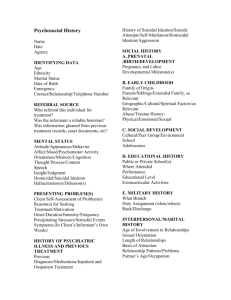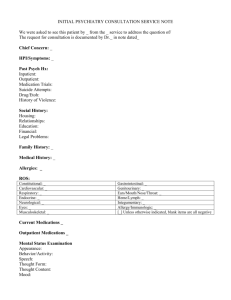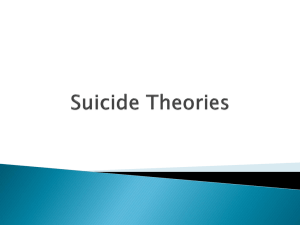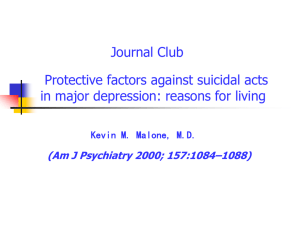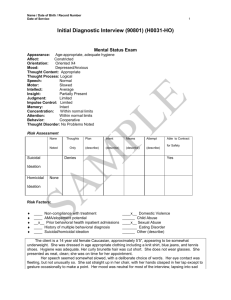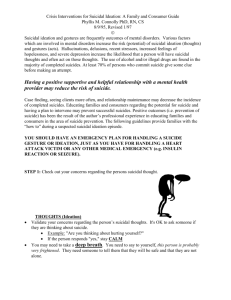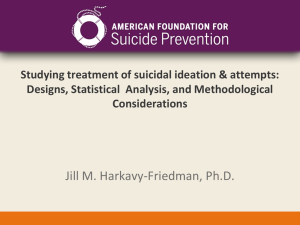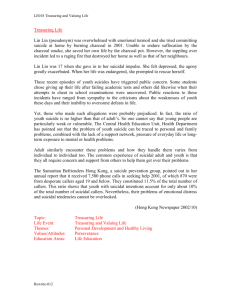314-937-1-RV - ASEAN Journal of Psychiatry
advertisement
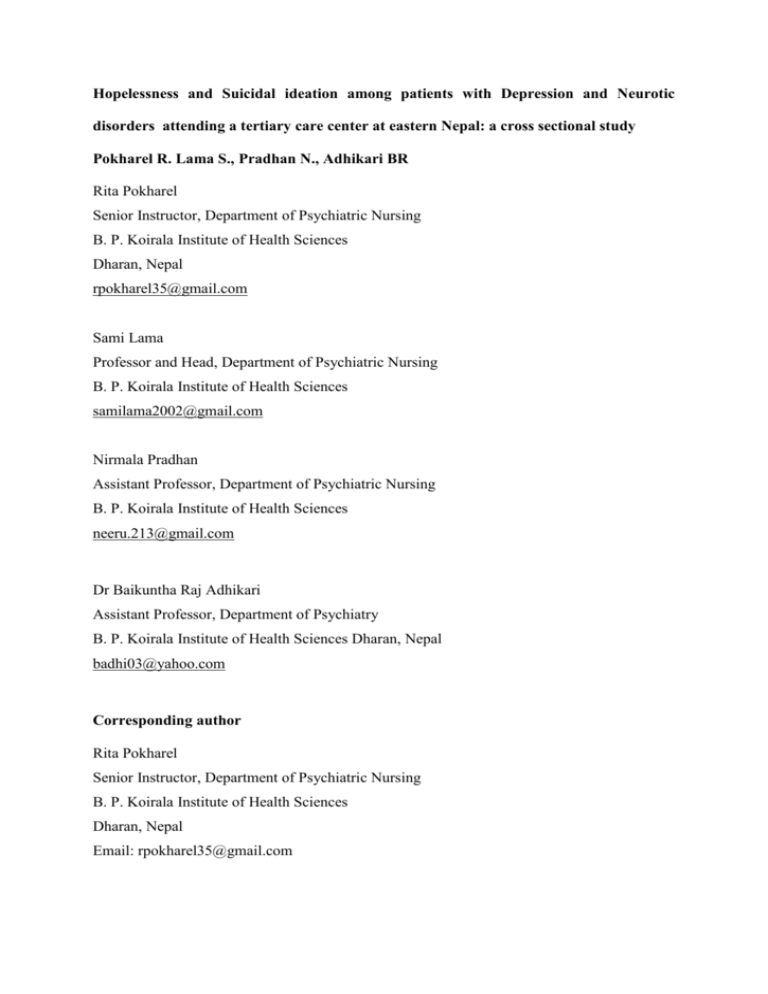
Hopelessness and Suicidal ideation among patients with Depression and Neurotic disorders attending a tertiary care center at eastern Nepal: a cross sectional study Pokharel R. Lama S., Pradhan N., Adhikari BR Rita Pokharel Senior Instructor, Department of Psychiatric Nursing B. P. Koirala Institute of Health Sciences Dharan, Nepal rpokharel35@gmail.com Sami Lama Professor and Head, Department of Psychiatric Nursing B. P. Koirala Institute of Health Sciences samilama2002@gmail.com Nirmala Pradhan Assistant Professor, Department of Psychiatric Nursing B. P. Koirala Institute of Health Sciences neeru.213@gmail.com Dr Baikuntha Raj Adhikari Assistant Professor, Department of Psychiatry B. P. Koirala Institute of Health Sciences Dharan, Nepal badhi03@yahoo.com Corresponding author Rita Pokharel Senior Instructor, Department of Psychiatric Nursing B. P. Koirala Institute of Health Sciences Dharan, Nepal Email: rpokharel35@gmail.com ABSTRACT Background: Hopelessness is thought to result from a negative appraisal system and interacts with, and worsens, appraisals of defeat and trap which in turn interact with suicide schema and lead to suicidal behavior. It is believed to mediate the relationship among depression, other stress related disorders and suicide. Various related studies done regarding actual scenario of suicidal ideation and hopelessness have been done in affluent countries and data of Nepal are scarce. So, this study was intended to assess Hopelessness and suicidal ideation among patients with depression and neurotic disorders at tertiary care center of eastern Nepal. Methods: A cross sectional design was used. Seventy respondents were included by purposive sampling. Data were collected by using semi structured questionnaire. Beck Hopelessness Scale and Scale of Suicidal Ideation were used to measure hopelessness and suicidal ideation respectively. Data were analyzed using SPSS statistical software. Pearson chi-square, binary logistic regression and Spearmans' rho, test were applied at 95% confidence interval. Results: Mean ± SD age was 32.8 ± 13.5 years. Most (62.8%) of the patients were female and with the diagnosis of depression. Majority (66%) of the patients had hopelessness. No significant difference in hopelessness among patients with depression and neurotic disorders. About 17% respondents had suicidal ideation, among them 82.4% were female. There was significant difference of suicidal ideation among patients with depression and neurotic disorders(p=0.013). Significant positive correlation between hopelessness and suicidal ideation was found (p=0.001). Hopelessness was independently related to income[OR=12.680 CI 2.943-54.636] and family history of mental illness [OR=12.813 CI 1.840-89.239]. Similarly, suicidal ideation was independently related to depression [OR=24.675CI 2.127-286.273] and family history of mental illness [OR=15.806 CI 1.716132.619]. Conclusion: Female respondents and people living under poverty had more hopelessness and suicidal ideation. Hopelessness and suicidal ideation may be reduced to some extent by alleviating poverty, providing education and proper care to the patients of depression and neurotic disorders. Key Words: Hopelessness, Suicidal ideation, Depression, Anxiety, Neurotic. Background Hopelessness takes away the possibilities of something to look forward in the future and some important reasons for living. Suicidal ideation arises as a symptom of depression, especially if there are reasons for a person to feel hopelessness. Still, a majority of individuals who experience suicidal ideation do not attempt suicide [1]. Depression is one of the oldest and one of the most frequently diagnosed psychiatric illness and the most common disorder in completed suicide[2,3]. The lifetime risk of depression in male is 8-12% and in female is 20-26%. One and a half decade’s armed conflict has tremendously increased the number of mentally ill people in Nepal. Therefore, mental illness like depression and anxiety are likely to be no less common in Nepal than in other low income countries [4]. The expression of hopelessness in conjunction with a mental disorder, such as depression represents a very dangerous warning sign and always needs to be taken very seriously. Numerous studies have shown that feeling of hopelessness in conjunction with a mental disorder can lead to suicide. In one study, the suicide attempt rates were 20% and 12% for persons with panic disorder and panic attacks, respectively [5]. Various studies done regarding actual scenario of suicidal ideation and hopelessness; their relation with mental disorders and with various demographic, educational, and socio-cultural factors have been done in affluent countries, as stated above. The prevalent scenario might be different in low income countries like Nepal because economic, educational and socio cultural backgrounds of people living in low income country like Nepal are different from those of developed countries where most of the studies were done. There is very little data regarding hopelessness, suicidal ideation, their relation with mental disorders and various demographic, educational, and socio-cultural factors in low income country like Nepal. Results of this study is expected to highlight the prevalent scenario of hopelessness and suicidal ideation; their relation with mental disorders and with various demographic, educational, and socio-cultural factors among people living in low income areas like Nepal. This will help to know if situation is different in this area as compared to western countries. This will also help to compare the findings of present study with various other studies done elsewhere. Methods Study setting A cross sectional study was conducted in department of psychiatry of a multi-specialty autonomous health sciences university of eastern Nepal. Participants Sample consisted of 70 patients with diagnosis of depression without psychotic symptoms, neurotic stress related and somatoform disorders diagnosed by psychiatrists following ICD10 DCR and without any co-morbidities were included in the study after having informed consent. Instruments Hopelessness scale It is a standardized tool developed by Aron T. Beck and Arlene Weismann, which consisted 20 true false items; score range from 0-20. The scale is interpreted as; score 0-3 minimal or no hopelessness, 4-8 mild; 9-14 moderate and 15 or more indicates severe hopelessness and definite suicide in future. In this study, scores were dichotomized as absence or presence of hopelessness less than four and more than or equals to four respectively. Suicidal ideation scale A standardized tool developed by Aron T Beck and associates. It is a 19 itemed scale and score range from 0-38. Higher score indicates higher suicidal risk. In this study, score 6 or more considered as suicidal ideators on the basis of a study at Helsinki [2]. Both scales were translated to Nepali language and back translated by different bilingual persons for semantic validation. Procedure Ethical clearance was obtained from ethical review board of institute before conducting the study. All patients with diagnosis of depression, neurotic, stress related and somatoform disorders from October 1 to December 28 2012, after obtaining informed consent and meeting the inclusion criteria. Only interviewer and respondent were present in interview room. Counseling by the interviewer and referral of respondents with hopelessness and suicidal ideation to treating psychiatrists was done. Data were entered into Microsoft excel 2007, prepared master chart, grouped and analyzed by a statistical software SPSS. Income was grouped on the basis of income according to world bank categorization of absolute poverty, Caste group was categorized according to National classification. Descriptive statistics were presented in mean, standard deviation, median, inter-quartile range, frequencies and percentage. Then education, diagnosis and hopelessness were dichotomized for inferential statistics. Inferential statistics Pearson chi-square test was applied to find out the significant association of hopelessness and suicidal ideation with socio-demographic and clinical variables. After obtaining the result of chi-square test, the variables which were significant at level of significance 0.2; were entered into binary logistic regression model to find out the associated confounding variables. The whole model was tested by Hosmer and Lemeshow Test for both hopelessness and suicidal ideation. For the entire statistical tests, confidence interval was 95%. Results Inter-item reliability (Cronbach's alpha) of the scales in this study was 0.88 for hopelessness scale and 0.93 for suicidal ideation scale. Bivariate analysis showed hopelessness was significantly associated with lower Income, lower education and family history of mental illness and treatment duration (table 1). Similarly place of residence, education and diagnosis of depression had significant association with suicidal ideation (table 3). Income below poverty line and family history of mental illness are significant risk factors for hopelessness after adjusting the confounding variables (table 2) in multivariate analysis. After controlling the confounding variables, diagnosis of depression and family history of mental illness were significant risk factors for suicidal ideation (table 4). Hopelessness and suicidal ideation score had significant positive correlation (table 5). DISCUSSION More than 50% of the patients in this were below 30 years of age. Female population was found 62.8%. These findings are consistent with a study of Khatri JB et al. done at Pokhara, Nepal among the patients of mental illness, which reported, 25.7% were below 30 years of age and most (50.4%) of the patients were female[6]. Similarly, a study of Coelho CLS et al. done in Brazilian population also found prevalence of major depressive disorder in Higher proportion of females than in males [7]. Higher proportion of female in this study could be because of high prevalence of mental illness especially depression and anxiety disorders in female population [6,7,8]. More patients in this study had per capita income above poverty line. A community based study done by Kohrt et al. in Jumla, Nepal found significantly higher depression and anxiety score in clients who had no income than who had any income [9] few other studies also found negative correlation of socioeconomic status with mental illness[7,10]. This shows that mental illness is not related to economic status and can equally affect both the economically strong and weak people in our settings. Other reason could be the financial condition might be one of the reasons for not seeking health care by poor people. These inconsistencies might be seen because of study conducted in hospital where people need some money for doctor visit and medicine. Very few (2.9%) of the patients were from Dalit caste group. People from Dalit caste group are educationally and financially backward in Nepal. One community based study done in Jumla district found that proportion of Dalit respondents were 23.7% and high burden of depression and anxiety was present in Dalit caste group [9]. In contrast, proportion of Dalit respondents in this study was low. This difference could be because, this study was hospital-based study and due to lack of awareness and financial strength, less proportion of Dalit people might be seeking heath services for mental illness. Similar to the result of a study by Johansson R. et al. done in Sweden, present study also found more respondents had educational level of higher secondary and above [11]. In contrast one study on prevalence of major depressive symptoms among Brazilian population, found most of the respondents were illiterate [7]. When education level increases, awareness of people increases thus people are more likely to seek health care services for mental illness. Mental illness have multi-factorial causation both genetic and environmental [3]. Almost one quarter (22.9%) of the respondents had family history of mental illness. More than eight percent of the respondents had family history of completed suicide among them more than 80% of the patients were first degree relatives of suicide completers. One study in Hungary also found higher suicide rates in the first degree and second degree relatives of suicide completers [12]. This simply reflects sharing of common genetic and environmental risk factors for causation of psychiatric problems including suicide. Majority patients were married in this study. Mental problems especially depression and suicide are more common among people who are single due to unmarried, divorced or widowed status [3,8]. The reasons for higher proportion of married respondents in this study might be because marriage may be stressful for vulnerable people, which may lead to the development of mental health problems. The interplay between marriage and mental health problems has been dealt with in detail by Indian and international authors [13]. One reason of higher proportion of married respondents in this study could be that a high number of people are migrant workers in Nepal [14]. So, spouse live singly despite marriage, assessment of this was beyond the scope of this study. Another reason of difference could be married people are more likely to get family support to seek treatment than who live singly. Almost equal proportions of respondents in this study were from rural and urban settings. The reason could be the study setting was referral center of eastern Nepal and patients are referred to this center from rural as well as from urban areas. Present study found that, depression was more common problem than neurotic disorders. One Korean study also found the most common Axis I diagnosis was Major Depressive Disorder [15]. Whereas, one Swedish epidemiological study found that anxiety disorder was more common than depression [11]. In countries like Nepal, many people do not seek medical help unless they become seriously ill and anxiety disorders are less serious types of illnesses. Therefore, More proportion of patients with depression might have come for seeking treatment. Hopelessness was present in higher proportion of patients with depression as compared to patients with neurotic disorders. However, this difference was not significant. In the study done by Haatainen et al, the prevalence of hopelessness increased with increasing severity of depression [16]. A Finnish study found significantly higher hopelessness score in patients with depression as compared to patients with other mental disorders [2]. According to result of present study, hopelessness should be investigated not only among patients with depression but also in patients with neurotic disorders because hopelessness seems to be common among both of these groups. Present study showed significantly higher proportion of respondents with depression had suicidal ideation as compared to respondents with neurotic disorders after adjusting other variables in multivariate analysis [OR 24.675 95% CI 2.127- 286.273]. Few other studies have also found higher SSI score in patients with depression [2,17,18]. However, one study in South Korea found higher SSI score among patients with trait anxiety after adjusting depression in multivariate analysis [15]. Significant and independent relationship between hopelessness and income of respondents was found in this study. People, who were below poverty line, had higher hopelessness score as compared to people who were above poverty line. Haatainen et al. also found that financial condition was independently associated with hopelessness score [16]. This shows the importance of poverty alleviation program for prevention of hopelessness among people which may ultimately reduce number of suicides in future. Policy makers need to consider optimal methods of intervention for mental disorders and suicidal behavior among lowincome individuals. Large scale studies regarding association between hopelessness and socioeconomic condition can be done in future. In consistent with the result of a Finnish study, this study also showed place of residence had no significant association with hopelessness [16]. Similar to this study, Few other studies also reported that, higher proportion of female had hopelessness but is was not significant [16,19-21]. It is explained that, common response to a loved one’s suicide is an overestimation of one’s own responsibility, as well as guilt for not having been able to do more to prevent such an outcome [22]. However, this study did not reveal significant association between hopelessness and family history of suicide (odds ratio=0.000). On bivariate analysis, this study found people with low education and illiteracy had significantly higher hopelessness. However, the significance was lost in multivariate analysis. Similarly, hopelessness scores were comparable among different castes and among respondents with different treatment durations. These findings show that hopelessness can be equally prevalent in people with different educational backgrounds, different castes and people with different treatment durations. Therefore, assessment of hopelessness is equally important in patients of any caste, any educational background and even in patients towards recovery of illness. In consistent with this study, other studies also found the higher proportion of patients reporting suicidal thoughts were females but it was not significant [19,22,23]. In contrast to this finding, another study by Sokero P. et al. found more male suicidal ideators [2] and few studies found about equal percentage of male and female suicidal ideators [24]. The reason behind these inconsistent findings could be because of difference in sample size, distribution of gender among respondents and cultural differences. Result of present study showed that age and marital status were not significant factors for suicidal ideation. This finding is consistent with a study conducted in Hong Kong [25]. In contrast; one study found higher proportion of suicidal ideation in unmarried/single [22]. Another study found that marital status is one of the significant predictors of suicide [26]. The different result in present study could be because the study examined only suicidal ideation and not suicide. Present study showed significant association of suicidal ideation with family history of psychiatric illness but not with family history of suicide. However, few studies have found significant association between suicidal ideation and family history of suicide [15,27]. One cause of suicidal ideation in family members of psychiatric patients might be the stigma faced by them. Another reason could be the difficulties faced by them in caring psychiatric patients for a long time. The third reason of this result could be because of genetic sharing of mental illness, which ultimately increases the suicidal ideation. Present study found significant association between educational background and suicidal ideation [odds ratio: 3.375 95% CI (1.090-11.702)] but association was lost in multivariate analysis. Study by HY Choi et al. also found significant association between education and suicidal ideation in bivariate analysis [15]. Present study did not reveal statistical significant association between suicidal ideation and duration of treatment. This reflects the need of vigilance to the patients even they are in recovery phase. Likewise the finding of this study, different other studies have also found positive correlation of hopelessness with suicidal ideation [28,29]. This simply shows the importance of giving serious attention to the clients with hopelessness regardless of diagnosis and treatment duration for suicide prevention. Conclusions Hopelessness was independently and significantly associated with income and family history of mental illness in multivariate analysis. Level of hopelessness was not significant different between depressive and neurotic patients in. Suicidal ideation was independently and significantly high in respondents of depression and respondents with history of mental illness in family. Those findings clearly indicated to provide proper care to poor people and persons with family history of mental illness for prevention of suicide. It is important to assess level of hopelessness in patients with neurotic disorders as in patients with depression for prediction of suicide and prevent it on time. Competing interests None Authors' contributions RP collected the data, designed the study, analyzed the data, prepared the report. SL coordinated, guided, corrected and supervised the study, NP guided for conceptualize the study and contributed for manuscript. ABR supervised the study and interpretation, revised manuscript. All authors read and approved the final manuscript. Acknowledgements We wish to thank Dr. Surya Raj Niraula for his statistical support. References 1. Kessler RC, Borges G, Walters EE. Prevalence of and risk factors for lifetime suicide attempts in the National Comorbidity Survey. Arch Gen Psychiatry. 1999;56(7):617– 26. 2. Sokero P. Suicidal Ideation and Attempts Among Psychiatric Patients with Major Depressive Disorder [Phd Thesis]. Helsinki, Finland: University of Helsinki; 2006. 3. Townsend MC. Essentials of Psychiatric Mental Health Nursing. fifth edit. Philadelphia: F.A. Davis Company; 2011. 4. Koshishnepal.Mental Health in Nepal [Internet]. [Updated 2010; cited 2012 Nov 24]. Available from: http://www.koshishnepal.org/mentalhealth.html 5. Beck AT, Sanderson C, Steer A, Ed D. Panic Disorder and Suicidal Ideation and Behavior. Am J Psychiatry.1991;148:1195-99. 6. Khatri JB, St G, Thapa P, Ramesh K, Pk C, Bb T. Socio-demographic Characteristics and Diagnostic Profile of Patients Attending Psychiatric OPD of a Private Hospital in Western Region of Nepal. Nepal Med Coll J 2012;01(01). 7. Coelho CLS, Crippa AS, Santos JLF, Pinsky I, Zaleski M. Higher prevalence of major depressive symptoms in Brazilians aged 14 and older. Rev Bras Psiquiatr. 2013;35:142–9. 8. Sadock BJ, Sadock VA. Synopsis of psychiatry. 10th edition. New Delhi, Lippincott Wiliam & Wikins;2007. 9. Kohrt BA, Speckman RA, Kunz RD, Baldwin JL, Upadhaya N, Acharya NR, et al. Culture in psychiatric epidemiology: using ethnography and multiple mediator models to assess the relationship of caste with depression and anxiety in Nepal. Ann Hum Biol. 2009;36(3):261–80. 10. Hudson CG. Socioeconomic status and mental illness: tests of the social causation and selection hypotheses. Am J Orthopsychiatry. 2005;75(1):3–18. 11. Johansson R, Carlbring P, Heedman Å, Paxling B, Andersson G. Depression, anxiety and their comorbidity in the Swedish general population: point prevalence and the effect on health-related quality of life. 2013; 1:e98 http://dx.doi.org/10.7717/peerj.98. 12. Torzsa P, Rihmer Z, Gonda X, Szokontor N, Sebestyen B, Faludi G, et al. Family history of suicide: a clinical marker for major depression in primary care practice? J Affect Disord. 2009;117(3):202–4. 13. Nambi S. Marriage, mental health and the Indian legislation. Indian J Psychiatry. 2005;47(1):3. 14. Sijapati B, Limbu A. Governing Labour Migration in Nepal. Kathmandu: Himal books for center for the study of labour and mobility;2012. 15. Choi HY, Kim SI, Yun KW, Kim YC, Lim W-J, Kim EJ, et al. A Study on Correlation between Anxiety Symptoms and Suicidal Ideation. Psychiatry investig. 2011 ;8(4):320–6. 16. Haatainen K, Tanskanen A, Kylmaä J, Honkalampi K, Koivumaa-Honkanen H, Hintikka J, et al. Factors Associated with Hopelessness: A Population Study. Int J Soc Psychiatry. 2004;50(2):142–52. 17. Bhatia MS, Aggarwal NK, Aggarwal BBL. Psychosocial Profile of Suicide Ideators, Attempters and Completers in India. Int J Soc Psychiatry. 2000;46(3):155–63. 18. Hirsch JK, Ma PLV, Chang EC, Elizabeth L. Race and ethnic differences in hope and hopelessness as moderators of the association between depressive symptoms and suicidal behavior. J Am Coll Health. 2012;60(2):115–125. 19. Acosta FJ, Vega D, Torralba L, Navarro S, Ramallo-fariña Y, Fiuza D, et al. Hopelessness and suicidal risk in bipolar disorder. A study in clinically nonsyndromal patients. Compr Psychiatry. 2012;53(8)1103-9. 20. Haatainen KM, Tanskanen a, Kylmä J, Honkalampi K, Koivumaa-Honkanen H, Hintikka J, et al. Gender differences in the association of adult hopelessness with adverse childhood experiences. Soc Psychiatry Psychiatr Epidemiol. 2003;38(1):12–7. 21. Chioqueta AP, Stiles TC. Suicide Risk in Outpatients with Specific Mood and Anxiety Disorders. Crisis. 2003;24(3):105–12. 22. Young IT, Iglewicz A, Glorioso D, Lanouette N, Seay K, Ilapakurti M, et al. Suicide bereavement and complicated grief. Dialogues Clin Neurosci. 2012;14:177-186. 23. Khan TM, Sulaiman SAS, Hassali MA. Factors associated with suicidal behavior among depressed patients in Penang, Malaysia. Arch Med Sci. 2012;8(4):697–703. 24. Kamath P, Reddy YCJ, Kandavel T. Suicidal behavior in obsessive-compulsive disorder. The J Clin psychiatry. 2007;68(11):1741–50. 25. Kwok SYCL, Ideation S. Perceived Family Functioning and Suicidal Ideation. Nurs Res. 2011;60(6):422–9. 26. Atay M. Prevalence of Death Ideation and Attemptes Suicide and the Associated risk factors in Isparta Turkey. Turk Psikiyatri Derg. 2012;23(2):89-98. 27. Torres AR, Ramos-Cerqueira ATA, Ferrão YA, Fontenelle LF, do Rosário MC, Miguel EC. Suicidality in obsessive-compulsive disorder: prevalence and relation to symptom dimensions and comorbid conditions. J Clin Psychiatry. 2011;72(1):17–26. 28. Beck AT, Brown G, Steer RA. Prediction of eventual suicide in psychiatric inpatients by clinical ratings of hopelessness. J Consult Clin Psychol. 1989;57(2):309–10. 29. Brown GK, Beck AT, Steer R a., Grisham JR. Risk factors for suicide in psychiatric outpatients: A 20-year prospective study. J Consult Clin Psychol. 2000;68(3):371–7. Table 1 Association between Hopelessness and Characteristics of Patients with Depression and Neurotic disorders n=70 Characteristics Sex Place of residence Income Caste Marital status Age in years Education Diagnosis Family history of mental illness Family history of suicide Treatment duration in months Category BHS Score Odds Ratio Total p Value (95% CI) ≤3(%) >3(%) Male 10(38.4) 16(61.6) 26 1.399(0.486-3.689) 0.572 Female 14(31.8) 30(68.2) 44 Urban 14(42.4) 19(57.6) 33 1.989(0.731-5.416) 0.175 Rural 10(27.0) 27(73.0) 37 Above poverty 20(54.0) 17(46.0) 37 8.529(2.495-29.157) <0.001 Below poverty 4(12.1) 29(87.9) 33 Upper caste 13(38.2) 21(61.8) 34 1.407(0.522-3.789) 0.499 Others 11(30.5) 25(69.5) 36 Married 14(31.1) 31(68.9) 45 1.476(0.533-4.090) 0.453 Single 10(40.0) 15(60.0) 25 <30 14(38.8) 22(61.2) 36 1.000 30-50 9(36.0) 16(64.0) 25 1.131(0.393-3.254) 0.284 50-70 1(11.1) 8(88.9) 9 5.091(0.573-45.224) Higher 15(48.3) 16(51.7) 31 education 3.125(1.121-8.712) 0.027 Others 10(25.6) 29(74.4) 39 Depression 12(27.2) 32(72.8) 44 2.286(0.827-6.321) 0.108 Neurotic 12(46.1) 14(53.9) 26 disorders No 22(40.7) 32(59.3) 54 4.812(1.100-23.316) 0.037 Yes 2(12.5) 14(87.5) 16 No Yes First visit ≤3 3-12 >12 24(37.5) 1(20.0) 4(30.7) 7(31.8) 4(22.2) 9(52.9) 40(62.5) 5(80.0) 9(69.3) 15(68.2) 14(77.8) 8(47.1) 64 1.600(1.323-1.934) 0.064 6 13 2.759(0.599-12.710) 22 1.877(0.482-7.311) 0.270 18 3.804(0.854-16.934) 17 1.000 Table 2 Logistic Regression Analysis of Hopelessness Adjusted for Variables n=70 Risk Characteristics Rural place of residence Income below poverty line Diagnosis of depression Family history of mental illness Education other than higher p value 0.788 0.001 0.198 0.010 0.128 Odds Ratio 1.201 12.680 2.392 12.813 2.916 95% CI for EXP(B) Lower Upper 0.317 4.554 2.943 54.636 0.633 9.033 1.840 89.239 0.734 11.585 Table 3: Association between Suicidal Ideation and Characteristics of Patients with Depression and Neurotic Disorders n=70 SSI Score <6(%) ≥6(%) Male 23(88.4) 3(11.6) Sex Female 30(68.1) 14(31.9) Urban 29(87.8) 4(12.2) Place of residence Rural 24(64.8) 13(35.2) Above Poverty 30(90.9) 7(9.1) Income Below Poverty 23(62.1) 10(37.9) Upper Caste 28(77.7) 8(22.3) Caste Others 25(73.5) 9(26.5) Married 37(82.2) 8(27.8) Marital status Single 16(64.0) 9(36.0) <30 25(69.4) 11(30.6) Age in years 30-50 20(80.0) 5(20.0) 50-70 8(88.8) 1(11.2) Higher 27(87.0) 4(13.0) Education Education Others 26(66.6) 13(33.4) Neurotic 24(92.3) 2(7.7) Disorders Diagnosis Depression 29(65.9) 15(34.1) 43(79.6) 11(20.4) Family history No of mental illness Yes 10(62.5) 6(37.5) 50(78.1) 14(31.9) Family history No of suicide Yes 3(50.0) 3(50.0) First Visit 7(53.8) 6(46.2) Treatment ≤3 16(72.7) 6(27.3) duration in 3-12 15(83.3) 3(16.7) months >12 15(88.2) 2(11.8) Characteristics Category Total Odds Ratio (95% CI) p Value 26 3.578(0.918-13.941) 0.056 44 33 3.927(1.132-13.630) 0.025 37 33 0.537(0.177-1.625) 0.268 37 36 1.260(0.422-3.764) 0.679 34 45 2.602(0.850-7.961) 0.088 25 36 3.520(0.391-31.656) 25 2.000(0.201-19.914 0.393 9 1.000 31 3.375(1.090-11.702) 0.048 39 26 44 54 16 64 6 13 22 18 17 6.207(1.289-29.877) 0.013 2.345 (0.700-7.862) 0.160 3.571(0.648-19.678) 0.124 8.376(0.938-74.783) 2.725(0.439-16.902) 0.138 1.186(0.139-10.096) 1.000 Table 4 Logistic Regression Analysis of Suicidal Ideation Adjusted for Variables n=70 Risk Characteristics Female sex Marital status single Rural Place of residence Diagnosis of depression Family history of mental illness Family history of suicide Education other than higher Treatment duration first visit ≤3months 3-12 months >12 months p value 0.798 0.092 0.078 0.010 0.014 0.850 0.192 0.060 0.529 0.954 Odds Ratio 1.296 4.078 4.285 24.675 15.806 1.243 3.690 9.956 0.455 1.071 1.000 95% CI for EXP(B) Lower Upper 0.177 9.461 0.796 20.890 0.852 21.559 2.127 286.273 1.716 132.619 0.130 11.851 0.519 26.233 0.909 109.048 0.039 5.268 0.104 11.034 Table 5 Relationship between Suicidal Ideation and Hopelessness of Patients with Depression and Neurotic disorders. n=70 Variables Median (IQR) SSI score 0.00(0.00-4.50) BHS score 6(3.00-11.25) Spearmans' rho Correlation coefficient p value 0.40 0.001
